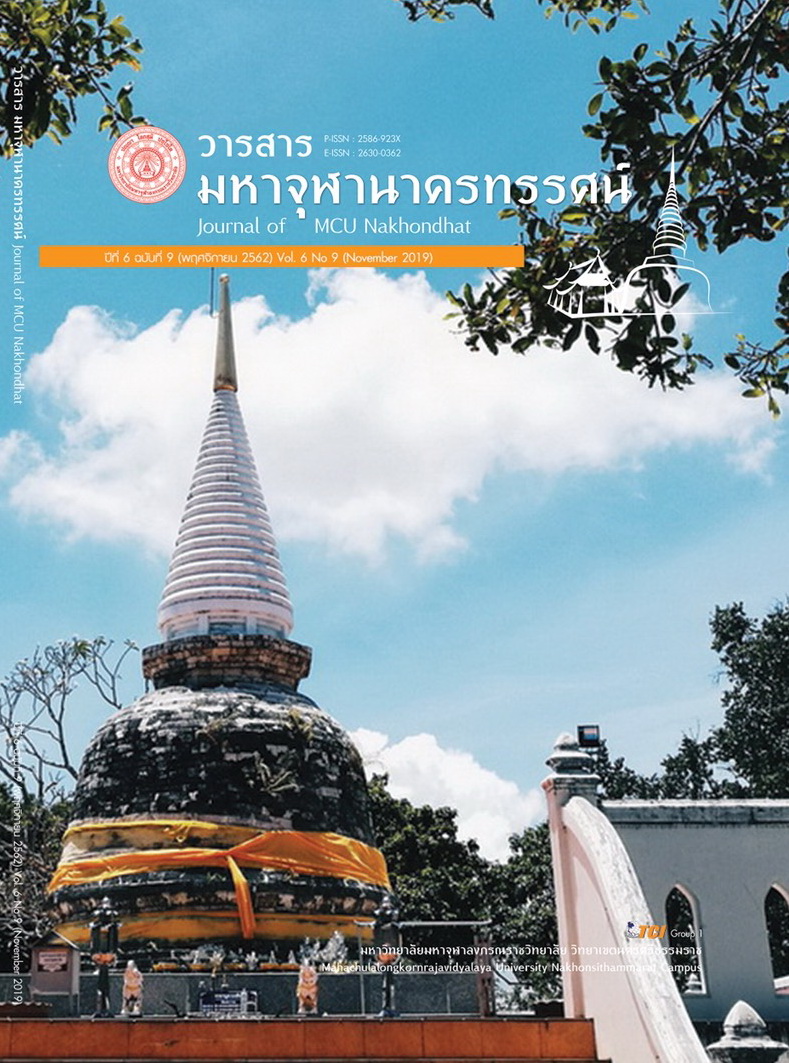SEVENFOLD KALANAMITTA-DHAMMA IN TIPITAKA FOR TEACHERS
Main Article Content
Abstract
A result of this study was found that a teacher was Kalanamitta, i.e. a good friend to help human beings sincerely without any want of compensation and to give good things faithfully. Seven aspects of good friends, called Kalanamitta-Dhamma, were (1) Piyo to encourage a teacher to have good human relations and to be a good model, (2) Caru (respectable) to ask a teacher to behave properly in a status, good practice, and good principles to live, (3) Bhāvaniyo to help a teacher to get faith as a person of good qualities: knowledge and wisdom, self-training and self-development, (4) Vattā ca to make a teacher know how to make the other person understand, when he could speak, to give good details, and to be a good advisor, (5) Vacanakkhamo to help a teacher patient in all obstacles and full of strong mind to win those obstacles, (6) Gambhiranca Katha Kattā to describe complex events and deep ideas for clear understanding, to act as speaking from a course of teaching or to attaining each levels of Dhamma before teaching, (7) No Catthāne Niyojaye to leave misleading the other persons into destruction. The teacher was actually a social leader and a social model praised by all people in societies. Thus, the teacher had to be pure in physical, verbal and mental action for all times and all places. The teacher had to produce a good model in order to make students full of faith and praise until they were pleased to follow his principles with love and happiness.
A teacher who followed Kalanamitta-Dhamma could produce great benefits. If there was a bad teacher, he would produce great damage among students. A good teacher would give academic knowledge, introduction and training about morality and ethics for a good way of practice and life. The teacher had to grow self-development, academic excellence, morality and ethics. The teacher had to be a good model of all students and people in societies.
Article Details
References
พระญาณสังวร (สุวัฑฒน มหาเถระ). (2536). สัมมาทิฏฐิตามเถราธิบายของท่านพระสารีบุตร. กรุงเทพมหานคร: มหามกุฎราชวิทยาลัย.
พระธรรมโกศาจารย์ (ปัญญานันทภิกขุ). (2538). วาทธรรมปัญญานันท. กรุงเทพมหานคร: ธรรมสภา.
พระธรรมปิฎก. (2542). ธรรมนูญชีวิต (ฉบับชาวบ้าน). กรุงเทพมหานคร: บริษัทสหธรรมิก จำกัด.
พระธรรมปิฎก. (2546). พจนานุกรมพุทธศาสน์ ฉบับประมวลศัพท์. (พิมพ์ครั้งที่ 11). กรุงเทพมหานคร: มหาจุฬาลงกรณราชวิทยาลัย.
พระธรรมปิฎก. (2552). พุทธธรรมฉบับปรับปรุงและขยายความ. (พิมพ์ครั้งที่ 8). กรุงเทพมหานคร: มหาจุฬาลงกรณราชวิทยาลัย.
พระพรหมคุณาภรณ์ (ป.อ. ปยุตฺโต). (2548). ธรรมนูญชีวิต. (พิมพ์ครั้งที่ 36). กรุงเทพมหานคร: โรงพิมพ์บริษัทสหธรรมิก จำกัด.
พระมหารัศมี ชุติโก. (2547). ศึกษาเปรียบเทียบมิตรภาพในพุทธปรัชญาเถรวาทกับอาริสโตเติล. ใน วิทยานิพนธ์พุทธศาสตรมหาบัณฑิต สาขาวิชาพระพุทธศาสนา. มหาจุฬาลงกรณราชวิทยาลัย.
พระราชวรมุนี (ประยูร ธมฺมจิตฺโต). (2541). เพื่อน. (พิมพ์ครั้งที่ 2). กรุงเทพมหานคร: มหาจุฬาลงกรณราชวิทยาลัย.
พุทธทาสภิกขุ. (ม.ป.ป.). ทิศธรรม ธรรมะที่เป็นทางเดินของมนุษย์. กรุงเทพมหานคร: สำนักพิมพ์ธรรมสภา.
มหาจุฬาลงกรณราชวิทยาลัย. (2500). พระไตรปิฎกภาษาบาลี ฉบับมหาจุฬาเตปิฎกํ 2500. กรุงเทพมหานคร: โรงพิมพ์มหาจุฬาลงกรณราชวิทยาลัย.
มหาจุฬาลงกรณราชวิทยาลัย. (2539). พระไตรปิฎกภาษาไทย ฉบับมหาจุฬาลงกรณราชวิทยาลัย. กรุงเทพมหานคร: โรงพิมพ์มหาจุฬาลงกรณราชวิทยาลัย.
มหาทองพูน สติสมฺปนฺโน (เสือเขียว). (2547). การคบมิตรในพระพุทธศาสนา. ใน วิทยานิพนธ์พุทธศาสตรมหาบัณฑิต สาขาวิชาพระพุทธศาสนา. มหาจุฬาลงกรณราชวิทยาลัย.
สมเด็จพระญาณสังวร สมเด็จพระสังฆราช (เจริญ สุวฑฺฒโน). (2531). ทศบารมีทศพิธราชธรรม. ใน มหาอุดมมงคลวโรกาสพระราชพิธีรัชมังคลาภิเษกพระบาทสมเด็จพระปรมินทรมหาภูมิพลอดุลยเดชมหาราช. วัดบวรนิเวศวิหารขอพระราชทานถวายเฉลิมพระเกียรติ.
สมเด็จพระพุฒาจารย์ (อาจ อาสภมหาเถร). (2546). แปลและเรียบเรียง คัมภีร์วิสุทธิมรรค. (พิมพ์ครั้งที่ 4). กรุงเทพมหานคร : บริษัท ประยูรวงศ์พริ้นติ้ง จำกัด.
โสภา ชปีลมันน์. (2536). บุคลิกภาพและพัฒนาการ : แนวโน้มสู่พฤติกรรมปกติและการมีพฤติกรรมเบี่ยงเบนของเด็กและเยาวชน. กรุงเทพมหานคร: โรงพิมพ์ โอ. เอส. พริ้นติ้งเฮ้าส์.


